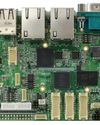Zero Trust Architecture for the Internet of Things
Circuit Cellar
|June 2025
Discover how Zero Trust Architecture is transforming IoT security, moving beyond outdated perimeter defenses to ensure every device, user, and service is authenticated and secure. Learn why adopting ZTA is essential for modern IoT design and how it can boost security, flexibility, and trust in your connected systems.

Traditional cybersecurity approaches focus on creating a trusted network of trusted devices and services with a perimeter of firewalls to keep attackers out. However, recent changes are forcing that “perimeter security architecture” to be abandoned for a more sophisticated “Zero Trust Architecture” (ZTA) where devices and services can reside anywhere globally, and no device or service is completely trusted.
A similar change is now coming to the Internet of Things (IoT), even in the Smart Home. This white paper explains how IoT security is being transformed by Zero Trust Architecture, why this change is happening, and what IoT designers must do to adapt.
PROBLEMS WITH PERIMETER SECURITY
For many years, cybersecurity used perimeter-based security with firewalls. This approach harkens back to the time of castles and moats in the Middle Ages. By keeping the bad guys outside of a castle's walls with a moat, the good (trusted) guys inside thought they were safe. When inside, no extra protection, such as armor, was necessary. How easy and efficient!
Unfortunately, perimeter security does not work well in modern cybersecurity. Attackers can use an email with a malicious link or a tempting ad on a web page to infect machines inside the perimeter. An infected machine becomes a base for observing unencrypted network traffic, scouting the target network, and infecting other machines. A more fundamental problem with the perimeter model is that users today spend much of their time outside the office and trusted services are often located in external clouds. Accommodating remote work in a perimeter security model requires extending the perimeter to include remote users and cloud services, which is a tremendous extension—and a substantial risk.
यह कहानी Circuit Cellar के June 2025 संस्करण से ली गई है।
हजारों चुनिंदा प्रीमियम कहानियों और 10,000 से अधिक पत्रिकाओं और समाचार पत्रों तक पहुंचने के लिए मैगज़्टर गोल्ड की सदस्यता लें।
क्या आप पहले से ही ग्राहक हैं? साइन इन करें
Circuit Cellar से और कहानियाँ

Circuit Cellar
The Future of Sensors in Safety Systems Sensing the Stop
How Magnetic Sensors Are Enabling the Next Generation of Braking Systems
5 mins
December 2025
Circuit Cellar
Alif Semiconductor Elevates Generative AI at the Edge with New Support for ExecuTorch Runtime in Its Ensemble MCUs
Alif Semiconductor, the leading global supplier of secure, connected, power efficient Artificial Intelligence and Machine Learning (AI/ML) microcontrollers (MCUs) and fusion processors, announced that developers can now use the ExecuTorch Runtime, a quantization extension of the popular PyTorch ML framework, for AI applications built to run on its Ensemble E4/E6/E8 series of MCUs and fusion processors.
1 min
December 2025

Circuit Cellar
Encrypted MQTT Protocol for Critical Sectors
Mechanisms, Challenges, and Best Practices
3 mins
December 2025

Circuit Cellar
Datasheet: Small Size, Big Power
Smaller Microcontrollers Bring New Possibilities
9 mins
December 2025

Circuit Cellar
Analog Devices Launches ADI Power Studio and New Web-Based Tools
Analog Devices, Inc. (ADI), a global semiconductor leader, announced the launch of ADI Power Studio, a comprehensive family of products that offers advanced modeling, component recommendations, and efficiency analysis with simulation.
1 mins
December 2025

Circuit Cellar
Compact IBR300 2.5" SBC Powered by NXP i.MX 93 from IBASE
IBASE Technology, Inc., a leading provider of rugged embedded computing platforms, announced the release of the IBR300, a 2.5\" RISC-based single board computer (SBC) powered by the NXP i.MX 93 processor with dualcore ARM Cortex-A55 (up to 1.7GHz) and a Cortex-M33 MCU.
1 min
December 2025

Circuit Cellar
Sensors in the Spotlight
The Next Decade of Embedded Sensor Systems
12 mins
December 2025

Circuit Cellar
Bob's Wrap Up
In Bob's last article with Circuit Cellar, he attempts to wrap up a career of more than 50 years as an embedded systems engineer and 14 years with Circuit Cellar. He looks at each of his 58 articles by category and provides some recommendations for his fellow engineers.
7 mins
December 2025

Circuit Cellar
Designing Embedded Software Architectures That Last
I've reviewed hundreds of firmware projects over the years, and one thing always stands out: the most successful projects have a clear, deliberate architecture.
10 mins
December 2025
Circuit Cellar
Broadcom Introduces Industry's First Wi-Fi 8 Silicon Ecosystem Powering the AI Era
Broadcom, Inc. unveiled the first Wi-Fi 8 silicon solutions for broadband wireless, targeting residential gateways, enterprise access points, and smart mobile clients.
1 mins
December 2025
Listen
Translate
Change font size

